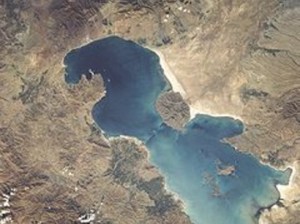 During the summer months of 2011, the fact was brought to the agenda that Lake Urmia, the third largest saltwater lake on Earth and the largest lake in the Middle East, located in northwestern Iran, has been shrinking. During periods with maximum amounts of water, the surface area of Lake Urmia was 140 kilometers from north to south, and 85 kilometers from east to west. In accordance with the Ramsar Convention it was included in the list of Wetlands of International Importance on June 23 1975, and it was also included in the list of Biosphere Reserves prepared within the framework of UNESCO�s Man and the Biosphere (MAB) program in 1976. Lake Urmia and its neighborhood, where endemic species are found, is a seasonal environment also for migratory birds. The lake is home to some 200 bird species and is an agricultural resource for 6.4 million people living in the area in addition to its ecological value. The approximate area of the lake is 6,100 square kilometers. The lake�s surface area, which started to shrink in the post-1995 period, is now down to 2,366 square kilometers as of August 2011 data. The water level of the shallow lake declined up to seven meters between the years 1995 and 2011.
During the summer months of 2011, the fact was brought to the agenda that Lake Urmia, the third largest saltwater lake on Earth and the largest lake in the Middle East, located in northwestern Iran, has been shrinking. During periods with maximum amounts of water, the surface area of Lake Urmia was 140 kilometers from north to south, and 85 kilometers from east to west. In accordance with the Ramsar Convention it was included in the list of Wetlands of International Importance on June 23 1975, and it was also included in the list of Biosphere Reserves prepared within the framework of UNESCO�s Man and the Biosphere (MAB) program in 1976. Lake Urmia and its neighborhood, where endemic species are found, is a seasonal environment also for migratory birds. The lake is home to some 200 bird species and is an agricultural resource for 6.4 million people living in the area in addition to its ecological value. The approximate area of the lake is 6,100 square kilometers. The lake�s surface area, which started to shrink in the post-1995 period, is now down to 2,366 square kilometers as of August 2011 data. The water level of the shallow lake declined up to seven meters between the years 1995 and 2011.According to studies conducted by the United Nations Environment Program (UNEP), 65 percent of the decline was from changes in inflow caused by climate change and diversion of surface water for use upstream, with the remaining balance due to construction of dams (25 percent), decreased precipitation over the lake itself (10 percent) and misuse of water. While the salinity level of the lake is 130-160 grams per liter under normal conditions, this level reached 330 grams per liter after it started to shrink and salt concentration of the lake increased, equal to 8 times the levels of sea water. The rise of salinity began to damage the existing ecosystem in the region.
The drying of the lake, which is located between Tabriz and Urmia with the majority of the country�s Azeri population, led to concerns in Iran, neighboring countries and especially in Azerbaijan.
In November 2011, a project launched by Iran in 2010 to direct 600 million cubic meters of water from the Aras River into Lake Urmia, which has been suffering from drought, was again brought to the agenda, with an approximated cost of $1.2 billion.
The Aras River, from which water is planned to be transferred, is a trans-boundary river where Turkey, Armenia, Azerbaijan and Iran are, as adjacent countries to the river, riparians. Iran signed bilateral agreements separately with Armenia and Azerbaijain on the use of the water in this natural border separating it from countries. In accordance with those agreements, water in the Aras is used by riparians at the rate of 50 per cent. Iran must speak with Azerbaijan regarding this agreement in the process of transferring water from the river.
Jabbar Vatanfada, director general of the Iranian Energy Ministry�s Office for Border Rivers and Joint Resources, stated that this plan could be put into practice as a result of talks and agreements with Azerbaijan and that they hope Azerbaijan will be supportive on the water transfer from the Aras River to Lake Urmia in the name of both regional relations and the environment. Azerbaijan, on the other hand, stated that they haven�t reached a decision regarding the plan and that Azerbaijan, which is not rich in terms of water resources, would decide in line with the interests of country. In this process, the impact of the Meghri Dam, which is planned to be jointly constructed with Armenia over the Aras River and which would be located on the Iran-Armenia border, on the plan was brought to the agenda. Vatanfada stated that hydropower energy would be generated in the dam and that this would not affect on the amount of water, thus it would not affect the water transfer project to Lake Urmia, either.
The UNDP provided Iran with $135 million for the recovery of Lake Urmia, which is shrinking with each passing day. In addition, Iran provided $900 million to save the lake in September 2011. The salt masses that will appear as a result of the drying of the lake will have to be carried to neighboring basins through clouds of dust, and could damage water and land resources. In addition, the lake�s disappearance would upset the economic, ecological and hydrological balance of Iran and neighboring countries. As the suggestions for saving Lake Urmia affect the water resources of riparian countries, the hydrological and ecological issues of the lake will affect the relations between neighboring countries as well.
By Today's Zaman
The Iran Project is not responsible for the content of quoted articles.










